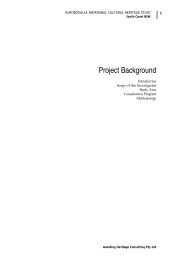Eurobodalla Integrated Water Cycle Management Strategy
Eurobodalla Integrated Water Cycle Management Strategy
Eurobodalla Integrated Water Cycle Management Strategy
Create successful ePaper yourself
Turn your PDF publications into a flip-book with our unique Google optimized e-Paper software.
<strong>Eurobodalla</strong> <strong>Integrated</strong> <strong>Water</strong> <strong>Cycle</strong> <strong>Management</strong> <strong>Strategy</strong><br />
<strong>Eurobodalla</strong>. The two options are either as a long term regular water source or as a drought<br />
contingency option.<br />
A desalination plant provides a drought proof supply source and the novel technology has<br />
potential to attract tourist visitation. It reduces the dependence on surface waters, however<br />
it produces a brine stream that must be disposed of. The plant needs to be located on the<br />
coast, which may reduce the visual amenity of the area and may be located on a potential<br />
development area. Desalination plants can be expensive to operate due to their high energy<br />
use, which can result in greenhouse gas emission. Like opportunities 2 and 3, it spreads<br />
risks associated with water supply including reducing reliance on extended delivery mains.<br />
Social and Environmental Aspects of the Long term Supply Opportunities<br />
The above opportunities, whilst being developed based on a 50-year planning horizon, will<br />
be implemented in stages. The TBL assessment table below provides the comparative<br />
environmental, social and economic benefit of each strategy option.<br />
Table 8-9 Social and Environmental Aspects – Long term Supply Opportunities<br />
Opportunities Social Environmental<br />
Opportunity 1<br />
Raise Deep Creek Dam<br />
Opportunity 2 New<br />
Southern Off-River Storage<br />
Opportunity 3 New Central<br />
Off-River Storage<br />
Opportunity 4 Desalination<br />
Maximises use of existing assets<br />
Drought security confined to one storage<br />
Limited construction work<br />
Spreads drought security (and water quality)<br />
risk between two storages and two supply<br />
sources<br />
Acceptance (and social impact) of proposal to<br />
build new storage<br />
Reduced reliance on extended delivery mains<br />
Spreads drought security risk between two<br />
storages but extraction based on one supply<br />
source<br />
More water available to environment and<br />
irrigators on Tuross River<br />
Acceptance (and social impact) of proposal to<br />
build new storage<br />
High pumping costs<br />
Plant located on possible development area<br />
Technology has potential to attract tourist<br />
visitation<br />
Public acceptance of this option for potable<br />
uses (unknown)<br />
Enhances drought-proofing of the scheme<br />
Reduced reliance on extended delivery mains<br />
Expensive to operate<br />
Proposal footprint<br />
predominantly confined to<br />
previously disturbed areas<br />
Further increases extraction<br />
from Moruya River, although in<br />
high flows<br />
River harvesting shared<br />
between two sources<br />
Creates a new footprint and<br />
associated environmental<br />
impact<br />
Increased reliance on Moruya<br />
River and higher environmental<br />
impacts to river environment<br />
Tuross River environment<br />
protected<br />
High energy use, resulting in<br />
greenhouse gas emission<br />
Potential issues with brine<br />
disposal<br />
Reduced dependence on<br />
surface waters<br />
The Project Team ranked the above opportunities. The triple bottom line assessment<br />
represented in Table 8-10 provides the relative ranking of each strategy option.<br />
87

















